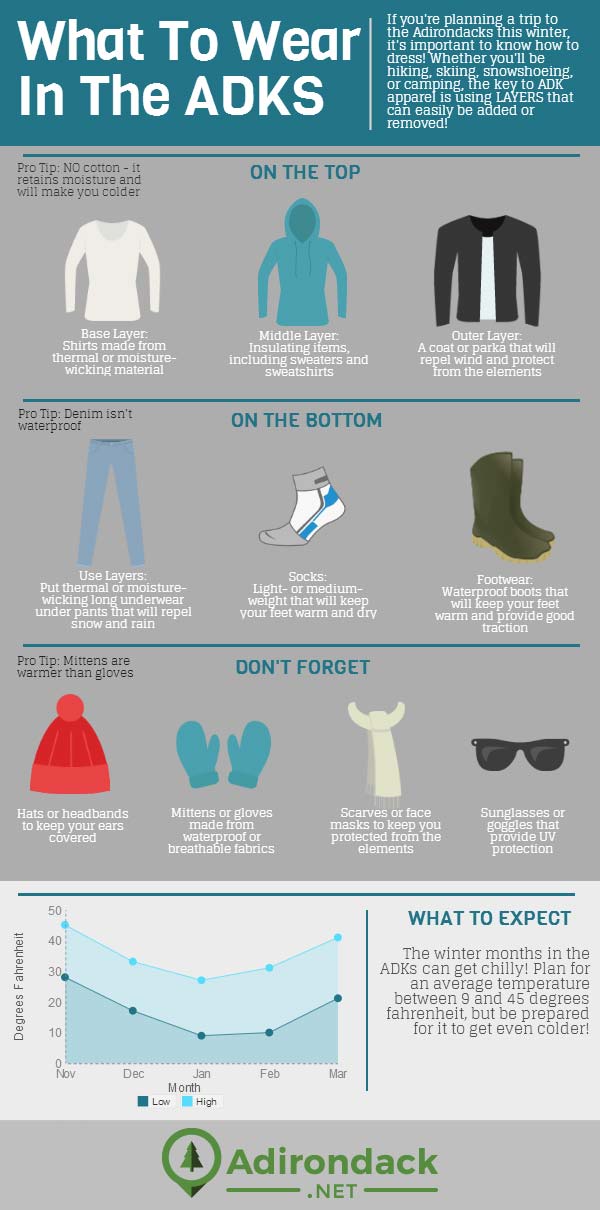Stay Warm & Safe! Winter Wear in the Adirondacks
Garnet Hill Lodge offers options for both activity and relaxation. Spend the day exploring the cross-country ski and snowshoe trail network, then retreat to the cozy Log House to warm up by the fire. Ski passes are included with overnight stays! Learn More »
Planning to enjoy some outdoor activities in the Adirondacks this winter season? Learn how to dress to make the most of winter while staying warm, safe, and comfortable.

Click here to jump to the text version of the infographic above »
Whether you plan to hike, snowshoe, or even go winter camping, the key to wearing apparel appropriate for Adirondack winters is using layers that can easily be added or removed. The image above shows how to layer appropriately.
For shirts and tops, avoid cotton; it retains moisture and will make you colder. Instead, choose a base layer made from thermal or moisture-wicking material. For your middle layer, choose insulating items, including sweaters and sweatshirts. For your outer layer, select a coat or parka that will repel wind and protect you from the elements.
For pants, avoid denim; it isn't waterproof and will stay damp for a long time, increasing your risk of hypothermia. Instead, use layers again, placing thermal or moisture-wicking long underwear under pants that will repel snow and rain. For socks, choose light or medium-weight ones that will keep your feet warm and dry. For footwear, choose waterproof boots that will keep your feet warm and provide good traction.
Hats are a must because they help you retain your body heat. Headbands will help you keep your ears covered. Mittens or gloves should be made from waterproof or breathable fabrics (note: mittens will be warmer). Scarves or face masks will help keep you protected from the elements. In addition, sunglasses or goggles will provide UV protection.
Text Version Of The Infographic Above
What To Wear In The ADKS
If you're planning a trip to the Adirondacks this winter, it's important to know how to dress! Whether you'll be hiking, skiing, snowshoeing, or camping, the key to ADK apparel is using LAYERS that can easily be added or removed!
On The Top
Base Layer: Shirts made from thermal or moisture-wicking material
Middle Layer: Insulating items, including sweaters and sweatshirts
Outer Layer: A coat or parka that will repel wind and protect from the elements
Pro Tip: NO cotton - it retains moisture and will make you colder
On The Bottom
Use Layers: Put thermal or moisture-wicking long underwear under pants that will repel snow and rain
Socks: Light- or medium-weight that will keep your feet warm and dry
Footwear: Waterproof boots that will keep your feet warm and provide good traction
Pro Tip: Denim isn't waterproof
Don't Forget
Hats or headbands to keep your ears covered
Mittens or gloves made from waterproof or breathable fabrics
Scarves or face masks to keep you protected from the elements
Sunglasses or goggles that provide UV protection
Pro Tip: Mittens are warmer than gloves
What To Expect
The winter months in the ADKs can get chilly! Plan for an average temperature between 9 and 45 degrees fahrenheit (as illustrated in the accompanying graph of low and high temperatures in the Adirondacks between November and March), but be prepared for it to get even colder!
See what to put in your backpack when hiking »
« Back to the Winter Hiking Guide
